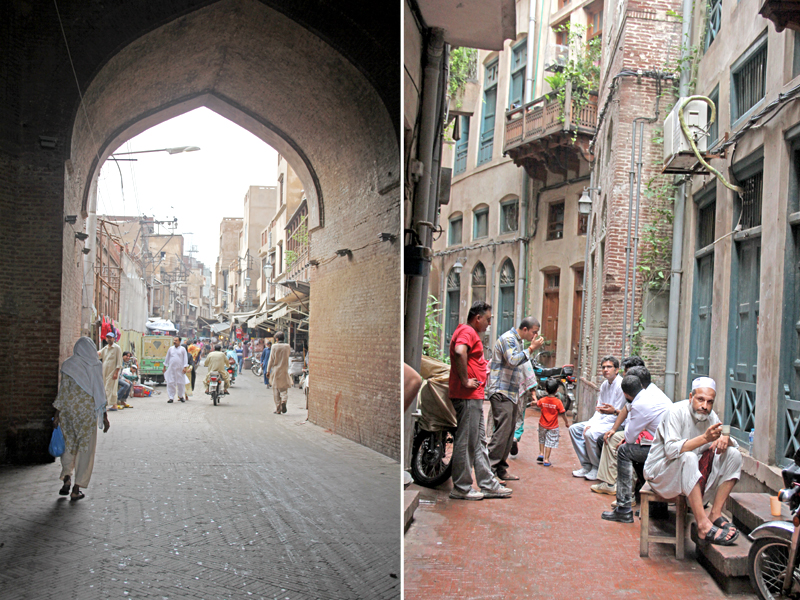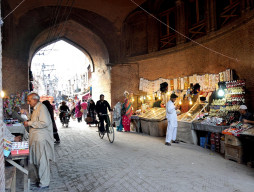
Located inside the Walled City’s Delhi Gate, Gali Surjan Singh is home to 13 residences. This week, conservation work on these homes and in the area received an ‘honourable mention’ from the UNESCO Asia-Pacific Awards for Cultural Heritage Conservation for “efforts of private individuals and organisations that have successfully restored and conserved structures and buildings of heritage value”.
The Gali Surjan Singh project includes a restoration of heritage architecture, replacement of infrastructure and services, including underground telecommunications, electricity, gas, water and sewerage. A total of 23 houses have been restored as part of the project, 13 of which were fully restored, and encroachments removed. Approximately Rs20 million was spent in the restoration of these 13 homes.
Gali Surjan Singh is named after Hakim Surjan Singh and it is believed that it dates back to the period of Maharaja Ranjeet Singh in 1849. In 2007, the Punjab government received financial support from the World Bank and technical and financial assistance from the Aga Khan Trust for Culture (AKTC) in order to begin a project of urban rehabilitation here that took into consideration the area’s historic nature and the lives of current residents.
Conservation work started in 2009 and was completed in 2011, in collaboration with the Punjab government, and included local residents, who were trained as part of the ‘skill enhancement programme’ and in order to boost a sense of ownership and pride in the area. Locals also paid 15 per cent of the cost of restoring their homes.
Residents were given training courses in electrical works, plumbing and carpentry and the use of the software AutoCAD, which enabled them to contribute to the creation of blueprints of the area. They were also trained in how to keep the streets clean. Data collection, including surveys and the area’s history, was also carried out by locals. One resident Shabbar Raza said his training helped him find employment with the Walled City of Lahore Authority (WCLA) later.
Before the restoration, the streets here were broken down, the water sewerage system and pipes leaking. Now, the street has been paved and the sewerage system replaced. An underground gas pipeline caters to the area and additional pipelines were included for the drainage of rainwater. All wiring was set up underground.
Social mobilisation teams worked to convince residents about the benefits of the conservation. It was these teams that, together with local activists, engaged with encroachers outside the 380-year-old Shahi Hamam (Royal Bath) and convinced them to temporarily resettle outside the Walled City through the payment of a compensation package. The teams continue to work in the area, instilling a sense of pride and achievement in the locals so that the conservation work is sustainable and protected.
“I was working with the Aga Khan Cultural Service (AKCSP) during the project,” said Haider Akbar, a resident of Gali Surjan Singh. “The best part of the project was that all the residents and the community were involved. We love our street and the project has really elevated our lifestyle and living standards.”
“The Walled City is one of the most historic sites in South Asia,” explained WCLA Director General Kamran Lashari. It covers an area of more than 260 hectares with an estimated population of over 160,000 according to the 1998 census. The Walled City is a repository of structures from the last 10 centuries, and includes the former royal precinct of the Lahore Fort (a world heritage site).
Lashari hoped the restoration would turn the area into a ‘gold mine of tourism’. Recognition by organisations such as UNESCO only spurs the residents and WCLA to work harder, he said.
“Lahore is a treasure trove of heritage and I hope our partnership with the Aga Khan Trust for Culture and the WCLA will revitalise the area,” said AKCSP CEO Salman Beg. “It is very motivating to have our efforts recognised by UNESCO,” added AKCSP Technical Director Maqsood Khan.
Published in The Express Tribune, September 7th, 2014.
COMMENTS (2)
Comments are moderated and generally will be posted if they are on-topic and not abusive.
For more information, please see our Comments FAQ










































@oBSERVER:
I have worked for cultural service and I can tell you ye katcha kaam nahin kartay hain,
Please revisit after rains and let us know.